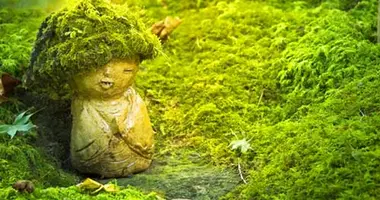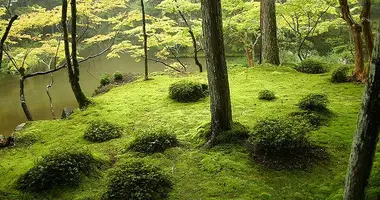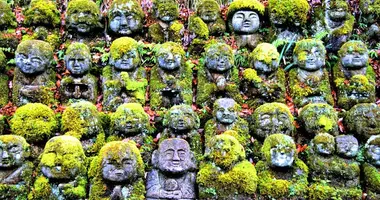Kitano Tenmangu Shrine Kyoto

Ema votive plaques showing an ox and prayers for success in examinations, Kitano Tenmangu Shrine, Kyoto
Nestled in the northwestern part of Kyoto, Kitano Tenmangu Shrine stands as a testament to Japan's rich cultural and spiritual heritage. Established in 947 AD, this Shinto shrine is dedicated to Sugawara no Michizane, a revered scholar, poet, and politician of the Heian period. As the first shrine in Japanese history to deify an actual person, Kitano Tenmangu holds a unique place in the country's religious landscape. Known as the god of learning, Tenjin (the deified form of Michizane) attracts thousands of students each year, especially during exam seasons, who come to pray for academic success. The shrine's beautiful architecture, seasonal attractions, and cultural significance make it a must-visit destination for both locals and tourists exploring Kyoto.
History and significance of Kitano Tenmangu Shrine
The story of Kitano Tenmangu Shrine is deeply intertwined with the life and legacy of Sugawara no Michizane. Born in 845, Michizane was a prodigious scholar who rose to prominence in the imperial court. However, political intrigue led to his exile to Dazaifu in 901, where he died two years later. Following his death, a series of calamities struck Kyoto, including plagues, droughts, and lightning strikes on the Imperial Palace. These events were attributed to Michizane's angry spirit.
To appease Michizane's spirit, the imperial court ordered the construction of Kitano Tenmangu Shrine in 947. This act marked the beginning of Michizane's deification process. In 986, Emperor Ichijo officially conferred upon Michizane the title of Tenman Tenjin, elevating him to the status of a deity. This unprecedented deification of a historical figure set Kitano Tenmangu apart from other Shinto shrines.
Over the centuries, Kitano Tenmangu has received patronage from emperors, shoguns, and influential families. Notably, Toyotomi Hideyoshi and his son Hideyori were significant patrons in the 16th and early 17th centuries, contributing to the shrine's architectural grandeur. The shrine's main hall and gates, built in the Momoyama period style, date back to 1607 and are now designated as National Treasures.
Sugawara no Michizane and the Tenjin faith
Sugawara no Michizane's transformation from a mortal scholar to the deified Tenjin is a fascinating aspect of Japanese religious history. As Tenjin, Michizane is revered as the god of learning, scholarship, and calligraphy. His association with education stems from his own intellectual prowess - legend has it that he could read and compose poetry by the age of five.
The Tenjin faith spread rapidly across Japan, with over 12,000 shrines now dedicated to Tenjin nationwide. However, Kitano Tenmangu remains the most significant, considered the headquarters of all Tenmangu shrines. The deity's influence extends beyond academia; he is also associated with agriculture, honesty, protection against false accusations, and the performing arts.
One of the most intriguing aspects of the Tenjin faith is the association with oxen. Cattle are considered Tenjin's sacred messengers, a belief rooted in the legend of Michizane's funeral procession. It's said that the ox pulling his remains suddenly stopped and refused to move, indicating where Michizane wished to be buried. Today, visitors to Kitano Tenmangu can find numerous ox statues throughout the shrine grounds, which are often rubbed for good luck.

Kitano Tenmangu Shrine, Kyoto, Japan
Architecture and national treasures
Kitano Tenmangu Shrine boasts impressive architecture that reflects its historical significance. The main shrine complex, constructed in 1607 under the patronage of Toyotomi Hideyori, is a prime example of Momoyama period architecture. Its ornate design, featuring elaborate wood carvings and gold-leaf decorations, has earned it the status of a National Treasure.
The approach to the shrine is marked by a massive stone torii gate, flanked by two guardian koma-inu. As visitors proceed, they encounter the impressive Rōmon Gate, a two-storied structure from the Momoyama period. Beyond this lies the Sankōmon, or the Gate of Three Lights, known for its colorful wood carvings depicting various mythical and real animals.
The main sanctuary, or Shaden, houses the inner sanctum where Tenjin's spirit is enshrined. Its architecture is characterized by a large, elegant roof that covers multiple buildings in a style known as "yatsumune-zukuri" (multi-building construction). The wooden carvings adorning the hall are attributed to the legendary artisan Hidari Jingorō.
Kitano Tenmangu also houses a Treasure Hall (Hōmotsu-den) that displays priceless artifacts collected over centuries. The most famous item in the collection is the Kitano Tenjin Engi Emaki, an illustrated scroll manuscript of the shrine's history, classified as a National Treasure. Other treasures include ancient documents, sacred swords, maki-e lacquer artworks, folding screens, and tea ceremony utensils.

Large torii gate at the entrance to Kitano Tenmangu Shrine

Kitano Tenmangu Shrine, Kyoto, Japan
Seasonal attractions and events
Kitano Tenmangu Shrine is renowned for its seasonal beauty and events throughout the year. Perhaps the most famous is the plum blossom viewing in late winter to early spring. The shrine grounds boast over 1,500 plum trees of about 50 different varieties, creating a breathtaking display of white, pink, and red blossoms. This spectacle is particularly meaningful as plum blossoms were Michizane's favorite flower.
The highlight of the plum blossom season is the Plum Blossom Festival (Baikasai) held on February 25th. This event features an outdoor tea ceremony where visitors can enjoy green tea served by geiko and maiko from the nearby Kamishichiken district. The festival has been held annually for over 900 years to commemorate Michizane's death anniversary.
In autumn, the shrine becomes a popular spot for viewing fall foliage. The Momiji-en (autumn maple garden) features about 350 maple trees that turn vibrant shades of red and gold. The garden is often illuminated in the evenings, creating a magical atmosphere.
Another notable event is the monthly flea market held on the 25th of each month. Known as Tenjin-san among locals, this market is one of the largest in Kyoto, offering a wide array of items from antiques and traditional crafts to street food and modern goods.

Kitano Tenmangu Shrine is famous for its plum blossoms
Visiting Kitano Tenmangu Shrine: Etiquette and customs
When visiting Kitano Tenmangu Shrine, it's important to observe proper Shinto etiquette. Upon entering the shrine grounds, visitors should bow slightly at the torii gate. Before approaching the main hall, it's customary to purify oneself at the chozuya (water pavilion) by rinsing hands and mouth.
At the main hall, visitors typically offer a small monetary donation, ring the bell, bow twice, clap twice, make a wish, and bow once more. Many visitors, especially students, purchase ema (wooden plaques) on which they write their wishes or prayers for academic success.
The ox statues scattered throughout the grounds are another unique feature of Kitano Tenmangu. Visitors often rub these statues for good luck, with different body parts corresponding to different blessings. For instance, rubbing the statue's head is believed to impart wisdom.
For those interested in a deeper spiritual experience, the shrine offers various Shinto rituals and blessings. These can range from simple good luck charms to more elaborate ceremonies for significant life events or academic pursuits.
Cultural importance and stored treasures
Kitano Tenmangu Shrine holds immense cultural importance beyond its religious significance. It serves as a repository of Japanese history, art, and tradition. The shrine's Treasure Hall houses a remarkable collection of artifacts that span centuries of Japanese cultural development.
Among the most significant treasures is the Kitano Tenjin Engi Emaki, a National Treasure that illustrates the life of Sugawara no Michizane and the history of the shrine. This scroll, along with other historical documents, provides invaluable insights into medieval Japanese society and religious practices.
The shrine also possesses an extensive collection of artworks, including paintings, calligraphy, and crafts gifted by emperors, shoguns, and other notable figures throughout history. These pieces not only demonstrate the shrine's prestige but also showcase the evolution of Japanese artistic styles over the centuries.
Kitano Tenmangu's cultural importance is further emphasized by its role in traditional events and ceremonies. The Baikasai festival, with its outdoor tea ceremony, is a prime example of how the shrine continues to preserve and promote traditional Japanese arts and customs.
Practical information for visitors
For those planning to visit Kitano Tenmangu Shrine, here's some essential information:
- Location: The shrine is located in the Kamigyō-ku district of Kyoto, easily accessible by public transportation.
- Hours: The shrine grounds are open daily from 5:00 AM to 6:00 PM (April to September) and 5:30 AM to 5:30 PM (October to March).
- Admission: Entry to the main shrine grounds is free. However, there may be fees for special exhibitions or events.
- Best times to visit: Late February to early March for plum blossoms, late November to early December for autumn foliage, and the 25th of each month for the flea market.
- Access: The shrine can be reached by bus from Kyoto Station (about 30 minutes) or via the Keifuku Line to Kitano-Hakubaicho Station.
Visitors should also note that the shrine can get quite crowded during peak seasons and on exam days when many students come to pray. For a more serene experience, consider visiting early in the morning or on weekdays.
Whether you're a history enthusiast, a spiritual seeker, or simply a curious traveler, Kitano Tenmangu Shrine offers a rich and rewarding experience. Its blend of natural beauty, historical significance, and living traditions makes it a must-visit destination in Kyoto, providing a deep insight into Japan's cultural and spiritual heritage.





























